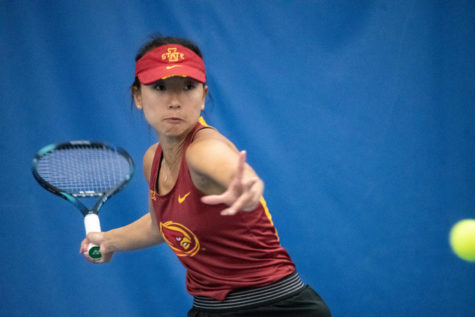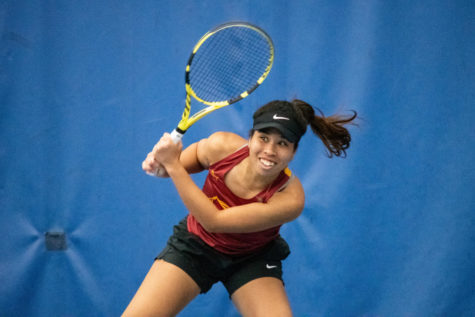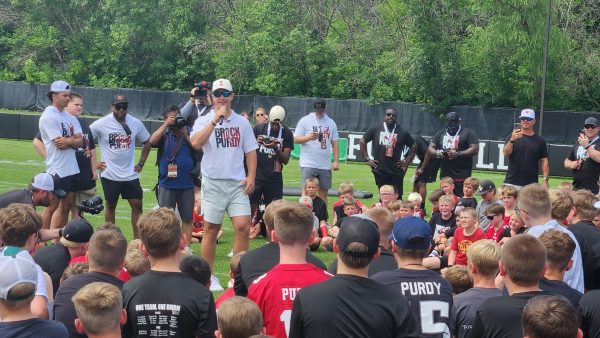‘Attitude, effort and competitiveness’: Boomer Saia and Iowa State’s tennis turnaround
Head coach Boomer Saia prepares the Iowa State tennis team ahead of their matches against Drake University at the Roger Knapp Tennis Center on Jan. 14, 2023.
January 18, 2023
To say that Iowa State tennis has been in a “turnaround” over the last few years is an understatement.
Over the past four years, the Cyclones have compiled three winning seasons, sent players to the ITA Fall National Championships for the first time and recorded their first-ever win in the Big 12 Tournament. In addition to that, they also made history by qualifying for the NCAA Championships in back-to-back seasons in 2021 and 2022, a feat that saw them record their first tournament victory, a 4-2 win against No. 28 South Carolina in the former.
All of this has been overseen by head coach Boomer Saia, who has guided the Iowa State program to heights it had never reached before. In the Big 12’s preseason rankings published on Jan. 4, the Cyclones earned the No. 4 spot for the highest in school history while also being ranked No. 22 in the Intercollegiate Tennis Association (ITA)’s latest poll.
For Saia, who is in his first head coaching job in collegiate tennis, the accomplishments on the court are a testament to the goals that he had in mind when accepting the job in 2018.
“I once had a coach tell me, ‘If you could learn something and you feel like you can make a program better, regardless of wherever their starting point is, then it’s an absolute yes,’” Saia said on accepting the Iowa State job. “I definitely threw myself in, and I have to commend our associate head coach Kenna [Kilgo]; she was right there with me. We had a vision of what this program could be, and we just chased it.”
That chase has come at the end of a fair share of the last decade spent coaching elsewhere in the Big 12 Conference. Saia started out as a volunteer assistant coach for Kansas in 2010 before spending time as an assistant at both Oklahoma and Texas Tech. He and Kilgo both joined a program that had finished the 2017-18 season with an overall record of 9-17 and went winless in the conference.
The first two seasons were a gradual build for Saia and his team, as they went 6-12 in the 2018-19 season. The next year saw the Cyclones produce stronger results as they posted an undefeated record in all of their home matches and snapped a 39-match losing streak against in-state rivals Iowa 4-3.
The COVID-19 Pandemic ultimately canceled the remainder of the spring season, but that year laid the foundation for Saia’s current squad. Seniors Thasaporn Naklo and Chie Kezuka debuted for Iowa State in the fall of 2019, and both have become cornerstones of the Cyclones team.
Naklo, who came to Iowa State from Bangkok, Thailand, has become the program’s leading singles player over the past four years. One of a handful of players to reach 100 career victories in program history, her arrival to Ames came through a unique contact by Saia.
“I think at first, [Saia] reached out to me through Facebook Messenger,” Naklo said, “And then he went to see me play in a junior tournament. We met and talked about Iowa State; he had just moved here [to Ames].”
Now under the coaching of Saia, Naklo heightened her achievements in her sophomore and junior years. She made history in 2022 by becoming the first individual player to qualify for the ITA and NCAA tournaments in the same season and finished the year ranked 39th in the country.
Kezuka has also carved out her place among the best players in school history. She, like Naklo, earned her 100th career victory this season and also qualified for the ITA Fall National Championships in November alongside teammate Ange Oby Kajuru.

She, like Naklo, also had her own long-distance communication with Saia before landing in Ames, a time she credits to influencing her choice to come to Iowa State.
“The first thing that I liked about him was that he was really supportive,” Kezuka said on Saia’s recruiting. “He contacted me a lot, [much] more than other coaches, and he was really supportive for me to come to the U.S. [for] college.”
In order to emigrate to the United States, Kezuka had to pass the Test of English as a Foreign Language (TOEFL) Exam, an English-language test that assesses the proficiency of non-native speakers. Despite not receiving the minimum number of marks in order to pass the exam, Saia stood by her and convinced her to join the team regardless, another case she said showed his loyalty.
“There weren’t that many coaches that helped me to enter into a U.S. college since I really needed to pass the English requirements, but [Saia] really supported me to get into Iowa State,” Kezuka said. “I could feel that he was really nice, as a person and as a coach.”
The shift of players from overseas has been a theme of Saia’s tenure as head coach. Seven out of the ten players on the roster of his first season’s team were born outside the United States. Today, all seven players on the Iowa State roster are from overseas, a fact that was highlighted again by the addition of Chinese player Xinyi Nong in late December of 2022.
This is not a stand-alone attribute of the Cyclones. However, as a study by the University of Oregon student newspaper, The Daily Emerald, found from 2014 to 2019, the percentage of Division I tennis players rose by 11%. The article also interviewed multiple players for their reasons to play collegiate tennis in the United States, finding their primary reason to be the “limited alternatives available to overseas tennis prospects.”
In regard to his own recruiting efforts, Saia acknowledged the difficulties in attracting potential players to come to play for Iowa State, a problem that he attributed to the school’s location.
“We’ve started to get more looks because of what we’ve done on court,” Saia said. “I would say that the challenge is still present. People will rule us out just based on geography before we even have a chance to speak to them. But, at the end of the day, I will feel really good if we can get a player on campus, and they can see how we operate around our team. The vision that we have it’s not going to speak to everybody, but we don’t want to recruit everybody. We want to recruit the right people. I think that’s what’s led us to where we are now… we got the right yesses.”
Saia has relished the opportunity to understand the perspectives and cultural backgrounds of his players, who range from multiple continents and countries around the world.
“I think we come from a very me-first society in today’s world, and so it’s being able to put those walls down, whatever those differences might be,” Saia said of the diversity of his team.
His players echo the sentiment. The usual team dinners before games and group activities aside, the diversity of backgrounds on the team, they say, has created a camaraderie that carries off the court as well as on.
“[Saia] really welcomed me as a person,” Kezuka said of her relationship with Saia, “He really treated us like his daughters, like his family. He was really welcoming [toward] myself and my culture. I think he really tried to understand me.”
Back on the court, Saia has tried to focus on not only improving his players’ drop shots or serves but also what he calls “the controllables”, especially in the mental aspects of a match. His vision of a grind-it-out type of player is built on “attitude, effort and competitiveness,” a model that particularly centers around a player’s body language.
“We put a high premium on body language and carrying yourself in the right way and what that process might look like physically as well as mentally,” Saia said.
Kezuka credited Saia’s coaching methods with helping her approach a match. The Fujisawa, Japan, native entered the Cyclone team in quiet fashion, posting a record of 17-14 in singles, but she went 10-3 in dual matches. Her form improved gradually, and by her junior year, she was Iowa State’s closer in the clutch.
Across her sophomore and junior seasons, Kezuka played in and won six matches that clinched victories for the Cyclones in dual meet play. During that time, she and her teammates also defeated 13 ranked opponents, including 11 that were ranked within the top 50. Her resume grew once more when she became the first Cyclone player to win a Big 12 individual title at No. 5 singles, as well as taking the doubles crown at the No. 3 spot with Kezuka.
“I didn’t have that much confidence when I came to the U.S.,” Kezuka said, “I think [Saia] really tried to give me confidence in myself, find the style that matched me. He always tried to tell me to be confident and aggressive. He always told me that the aggressive style is my style.”
This season, the Cyclones look again to blend both youth and experience as the spring season is set to begin. The spring campaign will be the last for Naklo and Kezuka, both of whom will graduate in May and end their careers as two of the winningest players in program history.
Right behind them look to be two of the Cyclones’ relative newcomers in Kajuru and sophomore Anna Supapitch Kuearum. Both have made an immediate impact this season, as they enter the dual meet season with national rankings in hand.
Kuearum earned a No. 80 singles ranking after producing a 10-3 record during her first fall season, including going 4-1 against players from the Big 12 Conference. Kajuru, as mentioned previously, formed a successful partnership with Kezuka, as the pair won the ITA Central Regional title and entered this spring season ranked 17th in the nation, the highest by a doubles pair in program history.
Naklo is optimistic about the team’s future under Saia’s leadership. Despite the turnover of players from this season to the next, she believes that the team’s experience in major events will help them in the long run.
“I think [Saia] could help the team to do very well, even better every year,” Naklo said, “Since we will experience bigger tournaments, I think that kind of situation will help us as a team to get better every year.”

For Saia, the lessons that he provides to his players in practice are ones that he hopes extend far beyond the tennis court. The embracing of the journey and all of the ups and downs that come with are what he hopes his players come away with even as they exit their athletic careers.
“It’s been fascinating to watch them all come together and also watch them not just believe but understand what competing truly means and knowing what they can hang their hat on,” Saia said. “Win or lose, [if] you give me 100 [percent], attitude, effort and competitiveness, to me that’s success… They might go have pro careers, but so much of this is life, and if I could have taught them anything, it’d be those things, and they will be successful in whatever they do.”

















